Childhood trapped in ‘leguna’
"This is Mohammadpur, get off," a child yelled out to the passengers of a leguna, otherwise known as human hauliers, which had reached the area as early as 7:00am.
Dressed in drab clothes, evidently tired and overworked, the 12-year-old still had the innocence of his age etched all over his face.
He then called out, "Next stop, Gabtoli! Gabtoli!"
When he was asked about his work schedule, the child said he remains on duty from 6:00am to 10:00pm, with only 20-minute breaks for lunch and dinner. The driver of the leguna, of which Abbas is a helper, helps cover the cost of his meals.
Despite the harsh realities of life that he is forced to face regularly, the child could not stop smiling when spoken to.
On good days, his earning varies between Tk 300 and Tk 400. Anything extra is taken by the driver.
Working as a helper for three years, he had to drop out of school when he was just in the third grade due to the demise of his father.
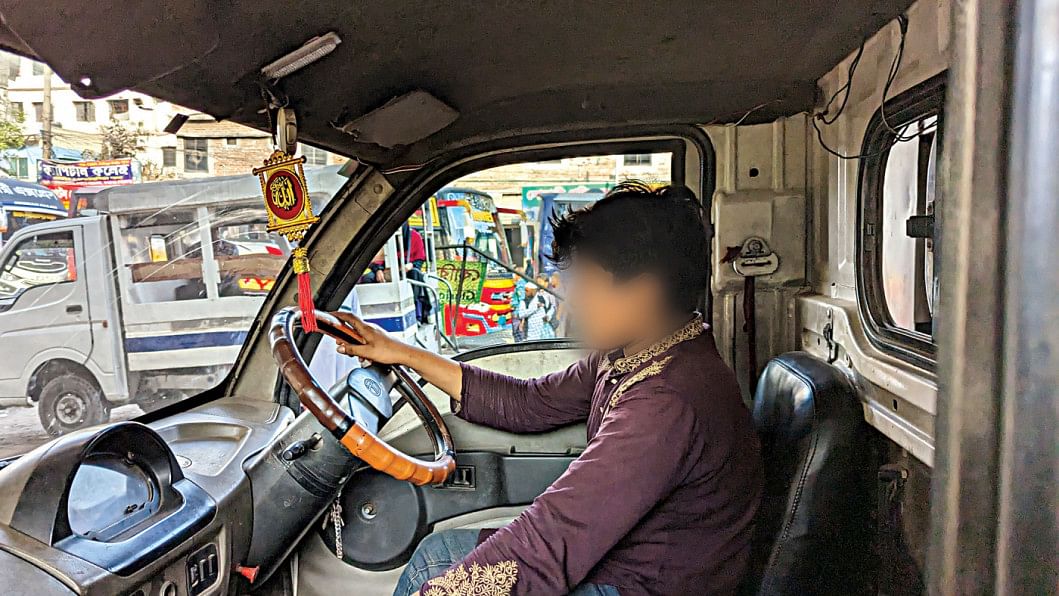
Abbas currently lives with his mother, an RMG worker in Chawkbazar, at Sabed Ali slum in the capital's Rayerbazar.
Like Abbas, 10-year-old Sabuj works as a leguna helper on a different route in Mohammadpur.
He began working at such a young age as his mother, a domestic help, could not help sustain their household expenses and his father has been bedridden for long due to an incurable disease.
Prior to Covid-19, there was an Out-of-School Children Education Programme, run by the non-formal education bureau, for children aged 9-14, who are most likely to drop out. The programme can be utilised to bring back most of the children who have left school during the pandemic period.
Sabuj has been working since he was only eight years old and earns Tk 300 per day.
A visit to the leguna routes in the capital revealed that countless children are employed as helpers. On Abbas's Gabtoli route alone, there are around 25 children working as leguna helpers.
According to the Children's Act 2013, working as a driver's assistant is identified as hazardous for those under 18 years of age. The labour and employment ministry on its official website has a list of jobs considered extremely hazardous for children. In it, "driver's assistant" or helper was one.
Despite these regulations, traffic police remain silent and do not take any action due to humanitarian reasons.
Speaking to this correspondent, an on-duty traffic sergeant in the Mohammadpur-Beribandh area, preferring anonymity, said, "If we stop them [from working], their families will starve since they depend on their earnings."
One of the reasons the number of children working as leguna helpers had increased was the Covid-19 pandemic.
During a recent visit to the leguna routes, it was found that the majority of children working are those who were compelled to discontinue their education during the Covid-19 period.
Previously a madrasa student, Siam, 16, now works as a helper on the Jatrabari-Postogola leguna route. Around 40 more -- all of whom had to drop out of school for the pandemic's impact on their families' financial situation -- work alongside.
A Unicef and Unesco report, titled "Situation Analysis on the Effects and Responses to Covid-19 on the Education Sector in Asia", published in October 2021, revealed that pandemic-induced school closures since early 2020 affected the education of 37 million children in Bangladesh.
In contrast, the Annual Primary School Census (APSC) 2021, prepared by the Directorate of Primary Education (DPE), disclosed that the number of students dropped from 21,551,691 in 2020 to 20,090,057 in 2021 -- meaning there was a 1,461,634 fall.
Shah Rezwan Hayat, director general of DPE, said, "DPE is working towards reintegrating these children back into school by increasing scholarships and the availability of non-formal education, and introducing half-day meals in primary schools from this October."
This correspondent also found that older children were working as drivers. Though the National Transport Act stipulates that professional drivers must be at least 21 years old, there is little to no practical enforcement of this rule.
Speaking to some of the drivers, it was learnt that owners usually benefit from hiring children as helpers as it is cheaper than hiring adult helpers, and children can also work for longer hours.
Due to severely limited information, it's unclear how many children are involved in child labour. Thus, the government must ensure that all dropped-out children are included in the non-formal education system.
WHAT EXPERTS SAY
Speaking to The Daily Star, Prof M Wahiduzzaman of Dhaka University's Institute of Education and Research said there was an urgent need to bring children involved in labour back to mainstream education.
"Prior to Covid-19, there was an Out-of-School Children Education Programme, run by the non-formal education bureau, for children aged 9-14, who are most likely to drop out. The programme can be utilised to bring back most of the children who have left school during the pandemic period.
"Furthermore, providing vocational training and one-time financial assistance for education security, along with raising awareness among families and implementing these solutions as quickly as possible, can bring a considerable portion of the children back to the mainstream education system."
Rasheda K Chowdhury, executive director for the Campaign for Popular Education, echoed the same and urged for the proper implementation of the government's non-formal education programme.
"Due to severely limited information, it's unclear how many children are involved in child labour. Thus, the government must ensure that all dropped-out children are included in the non-formal education system," she said.
THE ROUTES WITH MOST CHILDREN
The Mohammadpur area of the capital has four leguna routes -- Mohammadpur-Farmgate, Mohammadpur-Shyamoli, Dhaka University-Shyamoli, and Mohammadpur-Mohakhali.
Shockingly, one-third of the 125 helpers working on these routes are children who do not have access to education.
The Jatrabari area has over 10 operational leguna routes -- the highest in the capital.
The Jurain and Abdullahpur routes have 70 legunas, with at least 40 child labourers, operating almost 23 hours a day.
There is no specific information on the number of children working as helpers on legunas in different areas of the capital.
However, the Bangladesh Passenger Welfare Association conducted a survey in 2016 which revealed that 35 percent of the labourers on 85 Leguna routes in Dhaka were children.
Its secretary general Mozammel Haque Chowdhury said, "The number has certainly increased since then."
Delwar Hossein Chunnu, a member of Dhaka Metropolitan Human Haulier Owners Association, said children continue to work on legunas, despite efforts to stop child labour as they have no other means of earning a living and their families depend on them.
He suggested the government provides alternative opportunities for these children.
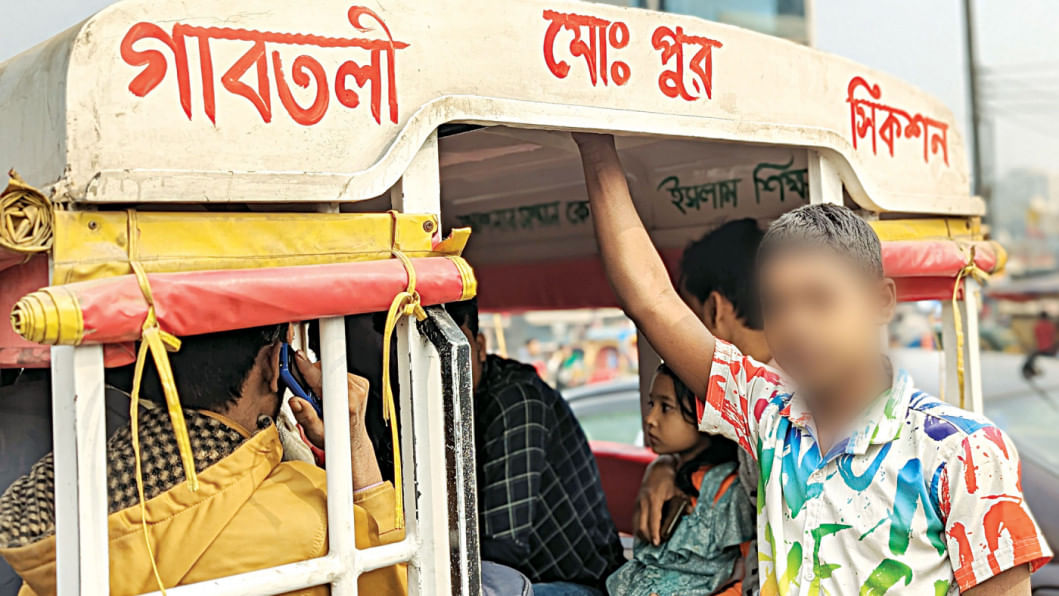
EFFORTS STILL ON
Due to the strict implementation of the Children Act 2013, child labour has become an issue of the past on several leguna routes in Dhaka.
The Daily Star's investigation found that no children are working on the Nilkhet-Chawk Bazar, Nilkhet-Gulistan, Nilkhet-Section, and Nilkhet-Farmgate routes.
Saiful Islam, a leguna driver on one of these routes, said they used to employ child helpers but had to stop due to strict enforcement of the law by the administration.
Similarly, no children are working in Gulistan, which has the largest leguna route. However, no helpers are employed there for cost-cutting purposes.
Mohammad Mujibur Rahman, additional commissioner (traffic) of Dhaka Metropolitan Police, admitted that due to the abundance of leguna routes in Dhaka, they have been unable to entirely eliminate child labour in the sector.
"Nonetheless, we have managed to stop it in some routes by handing punishment to owners and drivers who employ children. Moreover, we are collaborating with various organisations to raise awareness," he added.
(The names of the children have been changed and their faces in the pictures blurred to protect their privacy.)
Translated by Nilima Jahan, staff reporter, The Daily Star

 For all latest news, follow The Daily Star's Google News channel.
For all latest news, follow The Daily Star's Google News channel. 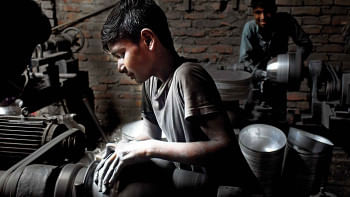
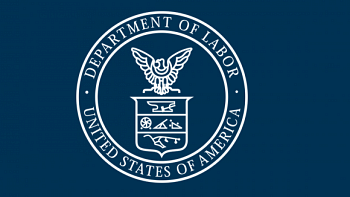
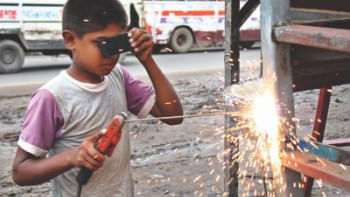



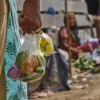

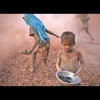
Comments